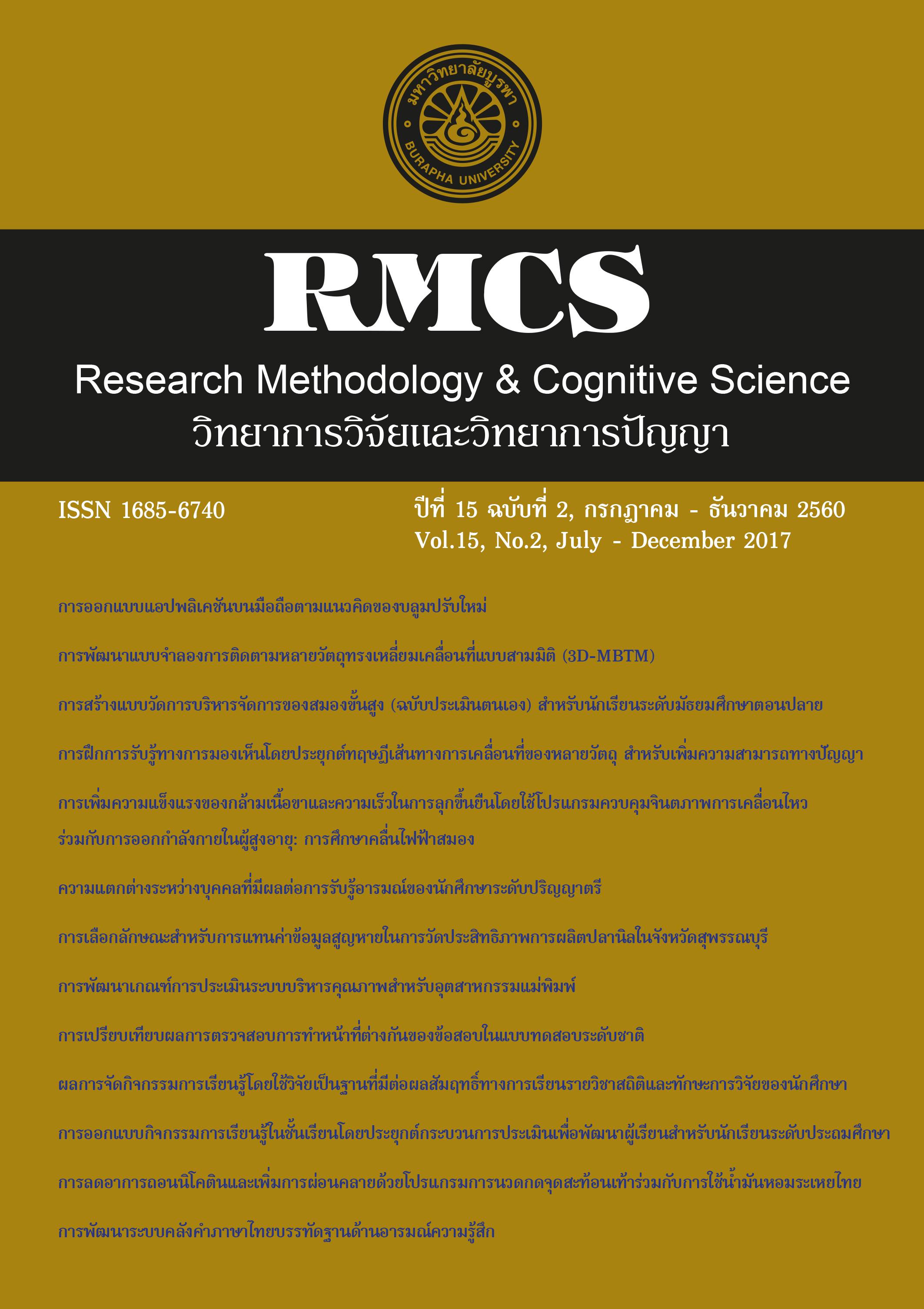การเปรียบเทียบผลการตรวจสอบการทำาหน้าที่ต่างกันของข้อสอบในแบบทดสอบ ระดับชาติ ด้านภาษา ด้านคำานวณ และด้านเหตุผล ชั้นประถมศึกษาปีที่ 3 ด้วยวิธี HGLM วิธี MIMIC และวิธี IRT-LR
Main Article Content
บทคัดย่อ
การวิจัยนี้มีวัตถุประสงค์เพื่อวิเคราะห์คุณภาพของแบบทดสอบระดับชาติ (NT) และตรวจสอบการทำหน้าที่ต่ างกันของ
ข้อสอบในแบบทดสอบระดับชาติชั้นประถมศึกษาปีที่ 3 ด้านภาษา ด้านคำนวณ และด้านเหตุผลด้วยวิธี HGLM
วิธี MIMIC และวิธี IRT-LR การดำเนินการวิจัยแบ่งเป็น 3 ระยะ ดังนี้ 1) วิเคราะห์คุณภาพของแบบทดสอบระดับชาติ ทั้ง 3
ด้าน 2) ตรวจสอบการทำหน้าที่ต่างกันของข้อสอบในแบบทดสอบระดับชาติ ด้วยวิธี HGLM วิธี MIMIC และวิธี IRT-LR
และ 3) เปรียบเทียบผลการวิเคราะห์การทำหน้าที่ต่างกันของข้อสอบ ด้วยวิธีการตรวจสอบ 3 วิธีข้อมูลที่นำมาใช้
วิเคราะห์เป็นข้อมูลทุติยภูมิ จากผลการตอบแบบทดสอบระดับชาติของนักเรียนชั้นประถมศึกษาปีที่ 3 ปีการศึกษา
2556 จำนวน 9,600 คน
ผลการวิจัยปรากฏว่า
1) แบบทดสอบระดับชาติชั้นประถมศึกษาปีที่ 3 มีค่าความยากของข้อสอบ (b) อยู่ในระดับค่อนข้างยากมีค่า
อำนาจจำแนกของข้อสอบ (a) อยู่ในระดับที่สามารถจำแนกผู้สอบได้ดี และมีค่าโอกาสในการเดาของข้อสอบ (c)
ไม่เกิน 0.3
2) การตรวจสอบการทำหน้าที่ต่างกันของข้อสอบทั้ง 3 ด้าน ชี้ให้เห็นว่า เพศส่งผลให้เกิดการทำหน้าที่ต่าง
กันของข้อสอบ โดยเพศหญิงจะได้เปรียบในการตอบข้อสอบด้านภาษา และด้านเหตุผล ในขณะที่เพศชาย
จะได้เปรียบในการตอบข้อสอบด้านคำนวณ โดยวิธี HGLM ตรวจพบข้อสอบทำหน้าที่ต่างกัน จำนวนมากที่สุด
คิดเป็นร้อยละ 69 ของข้อสอบทั้งฉบับ รองลงมาคือ วิธี IRT-LR ร้อยละ 54 และวิธี MIMIC ร้อยละ 16 ตามลำดับ
3) การเปรียบเทียบผลการตรวจสอบการทำหน้าที่ต่างกันของข้อสอบ พบว่า วิธี HGLM ตรวจพบ DIF มากกว่า
วิธี MIMIC ในด้านภาษา ด้านคำนวณ และด้านเหตุผล คิดเป็นร้อยละ 70, 36 และ 53 ตามลำดับ และวิธี HGLM ตรวจ
พบ DIF มากกว่าวิธี IRT-LR ด้านภาษา และด้านคำนวณ คิดเป็นร้อยละ 37 และ 13 และวิธี IRT-LR ตรวจพบ DIF
มากกว่าวิธี MIMIC ทั้ง 3 ด้าน คิดเป็นร้อยละ 33, 43 และ 40 ตามลำดับ ส่วนวิธี HGLM ตรวจพบ DIF น้อยกว่า
วิธี IRT-LR ด้านคำนวณ คิดเป็นร้อยละ 7 (p<.05)
Article Details
เอกสารอ้างอิง
พีรญา สูงเนิน, เสรี ชัดแช้ม และสมโภชน์ อเนกสุข (2552). การตรวจสอบการทำหน้าที่ต่างกันของข้อสอบในแบบ
ทดสอบพหุมิติ: การเปรียบเทียบระหว่างรายข้อกับรายหมวดข้อสอบ โดยใช้วิธีซิปเทสท์.วิทยาการวิจัยและวิทยาการ
ปัญญา, 6(2), 49-62.
สำนักงานปลัดกระทรวงศึกษาธิการ. (2554). แผนพัฒนาการศึกษาของกระทรวงศึกษาธิการฉบับที่สิบเอ็ด พ.ศ 2555-2559. กรุงเทพฯ: กระทรวงศึกษาธิการ.
Acar, T., (2013). Comparison of the group and intercept coefficient from HGLM and LR-DIF method. British
Journal of Science, 10(1), 12-20.
Acar, T., & Kelecioglu, H. (2010). Comparison of differential item functioning determination techniques: HGLM,
LR and IRT-LR. Educational Sciences: Theory and Practice, 10(2), 639-649.
De Ayala, R. J. (2009). The theory and practice of item response theory. New York: Guilford Press.
Finch, H. (2005). The MIMIC model as a method for detecting DIF: Comparison with Mantel-Haenszel,
SIBTEST, and the IRT likelihood ratio.Applied Psychological Measurement, 29(4), 278-295.
Kabasakal, K. A., Arsan, N., Gök, B., & Kelecioglu, H. (2014). Comparing performances (Type I Error
and Power) of IRT likelihood ratio SIBTEST and Mantel-Haenszel methods in the determination of
differential item functioning. Educational Sciences: Theory and Practice, 14(6), 2186-2193.
Kamata, A. (2001). Item analysis by the hierarchical generalized linear model. .Journal of Educational
Measurement, 38(1), 79-93.
Le, L. T. (2009). Investigating gender differential item functioning across countries and test languages
for PISA science items. International Journal of Testing, 9(2), 122-133.
Li, H., Hunter, C. V., & Oshima, T. C. (2013). Gender DIF in reading tests: A synthesis of research. In New
Developments in Quantitative Psychology(pp. 489-506). New York, Springer.
Ong, M. L., Lu, L., Lee, S., & Cohen, A. (2015). A comparison of the hierarchical generalized linear model,
multiple-indicators multiple-causes, and the item response theory-likelihood ratio test for detecting
differential item functioning. In Mellsap, R. E., Bolt, D. M., Van der Ark, L. A. & Wang, W. C. (Eds.),
Quantitative Psychology Research(pp. 343-357). DOI:10.1007-978-3-319-07503-7_22.
Taylor, C. S., & Lee, Y. (2012). Gender DIF in reading and mathematics tests with mixed item formats.
Applied Measurement in Education, 25(3), 246-280.
Yildirim, H. H., & Berberoglu, G. (2009). Judgmental and statistical DIF analyses of the PISA-2003
mathematics literacy items. International Journal of Testing, 9(2), 108-121.

